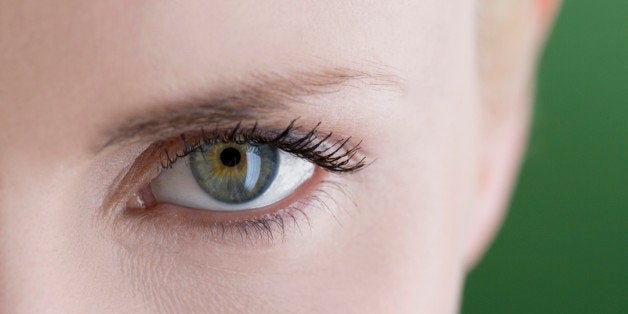
By Emma Haak
Ophthalmologists look into your body in a way no other doctor can, giving them surprising insights into what's going on.
What your doc is seeing: Fluid buildup under your retina, the light-sensitive layer of tissue at the back of the eye.
What it could mean: You've got too much on your plate. Doctors aren't exactly sure what causes this accumulation, but it's been linked to stress. There's also some early research suggesting that people with type A personalities, who are more prone to stress, are more likely to develop it. The fluid can lead to eyesight changes like dimming or blurring in the center of vision and objects appearing smaller in the affected eye. But before you start stressing about what your stress is doing to your eyes, know that the condition is pretty rare (Brenda Pagan-Duran, MD, an ophthalmologist in New Jersey and a spokesperson for the American Academy of Ophthalmology, says she only sees three to four cases of it per year), and it's about six times more common in men than in women.
Next step: The relationship between stress and fluid buildup doesn't appear to go both ways, so R&R, while great for your mindset, won't fix the problem. However, spontaneous recovery is common—most people regain normal vision within six months (if you don't, your ophthalmologist may suggest laser or light therapy to help seal the leak and bring your vision back to normal).
What your doc is seeing: One of your eyes won't close all the way.
What it could mean: You've had a close encounter with a tick. Bell's palsy can lead to paralysis of facial muscles, and today, particularly in the Northeast, one of the most common causes of Bell's palsy is Lyme disease, says Scott Greenstein, MD, FACS, an ophthalmologist at Massachusetts Eye and Ear in Boston. It can take several weeks to several months after the first symptoms of Lyme appear for nervous system effects like Bell's palsy to begin, but up to 15 percent of people infected with Lyme do develop problems with their nervous systems. The tick-borne infection can also lead to inflammation in the eye that your doctor would see during a routine exam.
Next step: Facial paralysis calls for blood tests, including the one that looks for Lyme. If it comes back positive, your doctor will prescribe antibiotics that should, with luck, clear up the paralysis as well as the Lyme.
What your doc is seeing: Super-dry eyes.
What it could mean: There are a lot of things that can make your eyes feel like the Sahara -- dry air, allergies, certain medications, not blinking enough. But if your doctor rules those out, an autoimmune disorder could be to blame, possibly Sjögren's syndrome. It causes white blood cells to attack moisture-producing glands in the body, especially in the eyes and mouth, and 9 out of 10 people diagnosed with the syndrome are women. Other conditions include rheumatoid arthritis, lupus, thyroid issues and blepharitis, an inflammation of the eyelids that also increases your chances of developing painful styes, says Greenstein.
Next step: There are several tests your eye doc could use to figure out if your dryness is beyond normal levels, including one that involves dropping (harmless) orange fluorescein dye into your eye and seeing how long it takes for your eye to start to dry out. If it's 10 seconds or less, you've got abnormally dry eyes. Autoimmune disorders can be notoriously difficult to diagnose (Sjögren's, for example, is often mistaken for menopause, fibromyalgia, rheumatoid arthritis and multiple sclerosis), so your doctor will probably refer you to a rheumatologist to nail down the specific cause and prescribe artificial teardrops to make it more manageable.
What your doc is seeing: Your eye looks a little red, and it's sensitive to light.
What it could mean: Uveitis, or inflammation in the uvea, the middle part of your eye. A closer look would also reveal inflammatory cells and proteins floating freely in the front of the eye. "It can be related to a systemic issue where the body's own immune system is attacking itself," says Emily Graubart, MD, an assistant professor of ophthalmology at the Emory Eye Center in Atlanta. The most common form of uveitis affects the front of the eye, and about 20 percent of the time it's related to an autoimmune condition, Graubart says. Possible culprits: rheumatoid arthritis, lupus or, if your doctor notices that your optic nerve is also inflamed, multiple sclerosis.
Next step: Your doctor will do a blood workup to test for the most common conditions related to uveitis and base the course of treatment on the results.
What your doc is seeing: A grayish ring around your cornea or yellow, fatty deposits on the skin around your eyes.
What it could mean: Your cholesterol is out of control. Those deposits are called xanthelasmas, and they can develop when your blood lipid levels are extremely high. Same goes for the grayish ring that goes around your cornea—it generally happens in extreme cholesterol cases only.
Next step: If you haven't already been diagnosed with high cholesterol, your ophthalmologist will tell you to bring it up with your primary care doctor. If you know your cholesterol is a problem, these symptoms could mean it's time to switch to more effective treatments. The fatty deposits may go away once you get your condition under control (though it's more likely that they'll require laser treatments or surgery), but the grayish ring, which doesn't affect vision, is there to stay.
What your doc is seeing: Cataracts forming earlier than they should.
What it could mean: You're a smoker, or you used to be. Cigarettes increase the risk of age-related cataracts, as a 2012 study confirmed. They can form at any age, and most of us will see early signs of growth in our 50s. But smokers can start to develop them in their 40s, especially in the center part of your lens. "The damage that smoking does to your cardiovascular system means that the lens of your eye isn't getting the right nourishment or oxygen, so it ages faster than it should," Graubart says. Early cataracts can also be caused by overexposure to UV light, diabetes or long-term use of corticosteroids for issues like asthma.
Next step: Cataracts are generally left alone until they start to affect your day-to-day life. Once that happens, your ophthalmologist will likely recommend cataract surgery to replace your cloudy natural lens with a clear artificial one.
What your doc is seeing: Damage to the blood vessels in the back of your eye.
What it could mean: You need to get your blood sugar and/or blood pressure checked. When you doc dilates your eye and takes a peek at your retina, the signs of diabetes and blood pressure run amok are obvious. High blood sugar can cause micro aneurisms, bulging in the blood vessels and bleeding, while sustained high pressure can lead to similar bleeding but also blockages or closings of the smaller vessels. "These two conditions are so easy to diagnose with an eye exam, and so many people just aren't getting routine physicals so eye doctors are often the first to notice them," Graubart says.
Next step: Your eye doctor will refer you to your general practitioner for tests to confirm. But if you've already been diagnosed, this could be a sign that you need to manage your condition better. The blood vessel damage can be reversed if you catch it early and begin treatment quickly.
What your doc is seeing: Lesions in the eye.
What it could mean: Cancer. But it's rare. The American Cancer Society (ACS) estimates just 1,220 cases of cancer in the eye or orbit (the socket where the eye sits) will be diagnosed in women this year (that includes cancers that originate in the eye too). To put that into perspective, the ACS estimates that 3,410 women will be diagnosed with cancer of the esophagus (considered a rare cancer among women) this year. The cancers most likely to spread to the eye are breast and lung, and it's possible that your ophthalmologist may notice something is off before you or your primary care doctor do. "I had a patient when I was a resident who came in and appeared to be completely healthy," Pagan-Duran says. "But when I dilated her eyes, I saw a lesion in the retina. Further testing found that she had breast cancer that had metastasized."
Next step: If your doctor suspects cancer, they'll send you to an oncologist to confirm and begin treatment.


